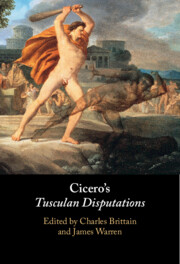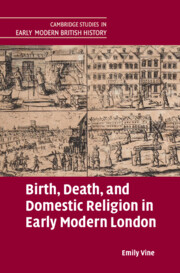Refine search
Actions for selected content:
400 results
Martyrs, Dreams, and Past Lives: Insurgent Immortality and the Expansive Logic of Debt
-
- Journal:
- Comparative Studies in Society and History , First View
- Published online by Cambridge University Press:
- 26 September 2025, pp. 1-25
-
- Article
-
- You have access
- Open access
- HTML
- Export citation
‘It should be my choice’: voluntary assisted dying needs and preferences of Australians living with dementia
-
- Journal:
- Ageing & Society , First View
- Published online by Cambridge University Press:
- 24 September 2025, pp. 1-25
-
- Article
-
- You have access
- Open access
- HTML
- Export citation
Chapter 4 - Cicero’s De morte
-
-
- Book:
- Cicero's <i>Tusculan Disputations</i>
- Published online:
- 11 September 2025
- Print publication:
- 18 September 2025, pp 56-78
-
- Chapter
- Export citation
Chapter 3 - Persuasion and Plausibility in Tusculans 1
-
-
- Book:
- Cicero's <i>Tusculan Disputations</i>
- Published online:
- 11 September 2025
- Print publication:
- 18 September 2025, pp 35-55
-
- Chapter
- Export citation
10 - Neighboring Death
-
- Book:
- Seniorland
- Published online:
- 04 September 2025
- Print publication:
- 18 September 2025, pp 167-183
-
- Chapter
- Export citation
“Public Hospitals in Critical Condition”: Death and Love as Embodied Care and Political Mobilization
-
- Journal:
- Business Ethics Quarterly , First View
- Published online by Cambridge University Press:
- 15 September 2025, pp. 1-31
-
- Article
- Export citation

Cicero's Tusculan Disputations
-
- Published online:
- 11 September 2025
- Print publication:
- 18 September 2025
12 - Joyce and the Everyday
-
-
- Book:
- The Cambridge Companion to James Joyce
- Published online:
- 14 August 2025
- Print publication:
- 21 August 2025, pp 200-215
-
- Chapter
- Export citation
6 - Liverpool 1974
-
- Book:
- Dreams and Songs to Sing
- Published online:
- 07 August 2025
- Print publication:
- 07 August 2025, pp 97-118
-
- Chapter
- Export citation
Chapter 5 - Dying and Deathbed Practices
-
- Book:
- Birth, Death, and Domestic Religion in Early Modern London
- Published online:
- 17 July 2025
- Print publication:
- 31 July 2025, pp 159-188
-
- Chapter
- Export citation
Chapter 6 - Domestic Religion in the Days After Death
-
- Book:
- Birth, Death, and Domestic Religion in Early Modern London
- Published online:
- 17 July 2025
- Print publication:
- 31 July 2025, pp 189-216
-
- Chapter
- Export citation
Chapter 4 - Daily Domestic Devotion and Preparation for Death
-
- Book:
- Birth, Death, and Domestic Religion in Early Modern London
- Published online:
- 17 July 2025
- Print publication:
- 31 July 2025, pp 125-158
-
- Chapter
- Export citation
Conclusion
-
- Book:
- Birth, Death, and Domestic Religion in Early Modern London
- Published online:
- 17 July 2025
- Print publication:
- 31 July 2025, pp 217-226
-
- Chapter
- Export citation
Introduction
-
- Book:
- Birth, Death, and Domestic Religion in Early Modern London
- Published online:
- 17 July 2025
- Print publication:
- 31 July 2025, pp 1-27
-
- Chapter
- Export citation

The Theology of the Book of Leviticus
-
- Published online:
- 18 July 2025
- Print publication:
- 07 August 2025

Birth, Death, and Domestic Religion in Early Modern London
-
- Published online:
- 17 July 2025
- Print publication:
- 31 July 2025
Death of the Gharīb: A Window towards a Regional Understanding of Displacement in the Middle East
-
- Journal:
- Comparative Studies in Society and History , First View
- Published online by Cambridge University Press:
- 17 July 2025, pp. 1-24
-
- Article
-
- You have access
- Open access
- HTML
- Export citation
Chapter 5 - Devon
- from Part I - Key Places and Events
-
-
- Book:
- Sean O'Casey in Context
- Published online:
- 23 June 2025
- Print publication:
- 10 July 2025, pp 57-66
-
- Chapter
- Export citation
Whose Grave’s This, Sir? An Ethico-Political Critique of Organized Resting Places
-
- Journal:
- Business Ethics Quarterly , First View
- Published online by Cambridge University Press:
- 27 June 2025, pp. 1-34
-
- Article
-
- You have access
- Open access
- HTML
- Export citation
Chapter 11 - The Possibility of Death
-
-
- Book:
- Heidegger's <i>Being and Time</i>
- Published online:
- 28 June 2025
- Print publication:
- 26 June 2025, pp 217-247
-
- Chapter
- Export citation
